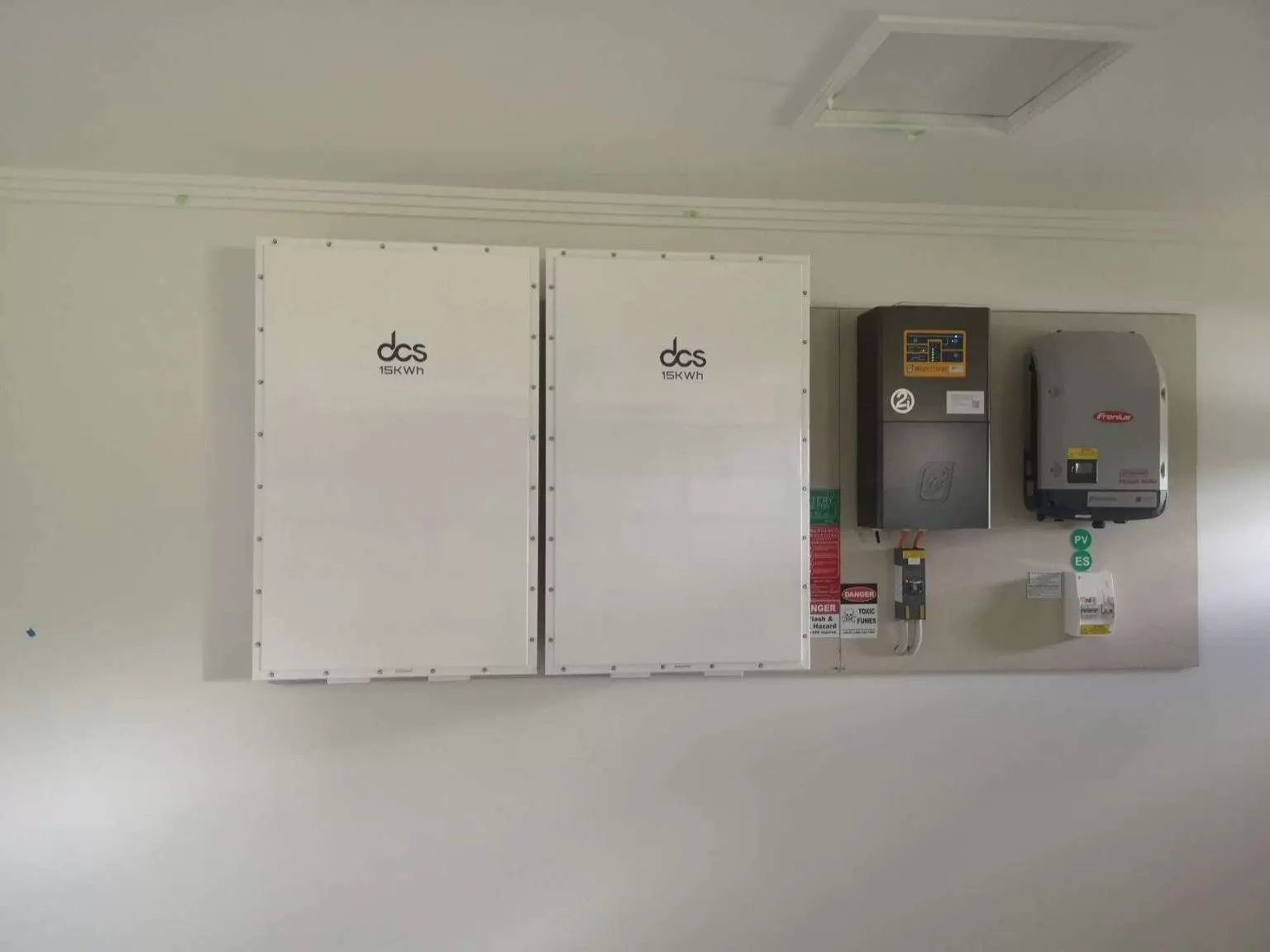In the realm of renewable energy, selecting the right solar battery is crucial for the efficiency and reliability of your setup. With technological advancements, consumers often choose between Lithium Ion Solar Batteries and traditional lead-acid batteries. This guide explores the features, advantages, and limitations of solar power storage, helping you navigate the complexities of solar power storage to make a well-informed decision tailored to your needs.
Comprehending Lithium-Ion Solar Batteries
Lithium-ion solar batteries have redefined how energy is stored and used in solar power systems. These batteries are known for their high energy density, which allows for more efficient energy storage in a compact form. They are also lightweight, making installation easier and more flexible. One of the standout features of lithium-ion batteries is their extended lifespan, typically lasting between 10 to 15 years, far surpassing the 3 to 5-year lifespan of lead-acid batteries.
Their advanced technology requires minimal maintenance, providing a hassle-free experience for homeowners and businesses alike. Additionally, lithium-ion batteries charge and discharge with higher efficiency, making them an ideal choice for those seeking to maximise the performance of their solar energy system. With their ability to handle frequent charging cycles, these batteries are becoming the go-to option for modern solar power solutions.
Investigating Lead-Acid Batteries
Lead-acid batteries have been a staple in energy storage for many years, particularly in solar power applications. They are favoured for their initial affordability, which makes them a popular choice for those on a tight budget. These batteries can deliver powerful bursts of energy, which can be advantageous in specific applications requiring short-term, high-power outputs. However, lead-acid batteries come with certain limitations. Their lifespan is much shorter than lithium-ion batteries, usually around 3 to 5 years.
Additionally, they require regular maintenance, including monitoring electrolyte levels and cleaning terminals to prevent corrosion. While they are robust and reliable, lead-acid batteries degrade more quickly, especially in extreme conditions. Despite these drawbacks, they can still be an effective and cost-efficient solution for smaller or budget-conscious solar systems where long-term performance is not a primary concern.
Evaluating Energy Efficiency
Energy efficiency plays a pivotal role in determining the effectiveness of a solar power storage solution. Lithium-ion batteries lead the charge in this category, with superior charge and discharge efficiency compared to their lead-acid counterparts. This high efficiency means lithium-ion batteries can store and release more energy, reducing the overall losses during energy conversion.
In contrast, lead-acid batteries suffer from higher energy losses during the charging and discharging cycles, which can limit the effectiveness of a solar power system. These energy losses result in more frequent charging requirements, increasing energy costs. Therefore, lithium-ion batteries are the choice for those looking to maximise their energy efficiency and reduce overall energy, offering better performance and greater overall savings in the long run.
Financial Considerations
The initial financial investment is a major factor when choosing between lithium-ion and lead-acid batteries. Lithium-ion batteries are typically more expensive upfront than lead-acid batteries. However, this higher initial cost is offset by their longer lifespan and lower maintenance requirements, which ultimately results in a lower total cost of ownership over time. Lead-acid batteries, while more affordable initially, incur higher ongoing maintenance costs and need to be replaced more frequently.
This can add up over the years, making them less cost-effective in the long run. Furthermore, the energy inefficiency of lead-acid batteries can lead to higher operational costs due to more frequent charging cycles. Lithium-ion batteries provide better value over time for those willing to make a higher initial investment due to their superior longevity and performance.
Longevity and Robustness
One of the key advantages of lithium-ion batteries over lead-acid alternatives is their longevity. Lithium-ion batteries can last up to 15 years or more with proper care, significantly outperforming lead-acid batteries, which typically last between 3 and 5 years. This extended lifespan results from the advanced technology and superior materials used in lithium-ion batteries, which are less prone to degradation over time.
Lithium-ion lithium batteries are also built to withstand a wider range of environmental conditions, including extreme temperatures, without compromising performance. Lead-acid batteries, known for their durability in certain situations, tend to degrade more quickly under harsh conditions. The robust nature of lithium-ion batteries ensures they continue to perform efficiently and reliably, even in challenging settings, making them a long-term solution for solar power storage.
Maintenance Demands
Maintenance is an important consideration when choosing a solar battery, as it can affect both the convenience and cost of your system. Lithium-ion batteries are designed to be low-maintenance, with many models requiring little more than occasional cleaning to maintain optimal performance. Their sealed design eliminates the need for routine electrolyte checks, and they don’t suffer from the corrosion and wear that can affect other types of batteries. In contrast, lead-acid batteries require more frequent attention.
For instance, users must regularly check the electrolyte levels and clean the battery terminals to prevent corrosion, which can affect performance. Lead-acid batteries also need to be properly ventilated to avoid the buildup of gases. This higher maintenance demand can be time-consuming and may not be ideal for those seeking a more hands-off solution. For users in remote locations or those with limited access to professional services, the low-maintenance nature of lithium-ion batteries is a key advantage.
Suitability for Remote Systems
When choosing the right battery for remote solar power systems, factors like lifespan, maintenance, and performance under varying environmental conditions must be considered.
Lithium-Ion Batteries: Low Maintenance and Long Lifespan
Lithium-ion batteries are popular for off-grid solar systems due to their long lifespan and low maintenance needs. These batteries can last many years, ensuring remote users can rely on their solar power systems without frequent service or attention. This makes them especially suited for isolated locations where regular maintenance might not be practical.
Performance in Harsh Climates
One of the major benefits of lithium-ion batteries is their ability to perform well in extreme temperatures and harsh environmental conditions. Whether in cold or sweltering heat, these batteries maintain their efficiency, making them ideal for remote areas where the weather can be unpredictable.
Limitations of Lead-Acid Batteries
In contrast, while cheaper upfront, lead-acid batteries tend to require more maintenance and have a shorter lifespan. They also degrade faster over time, reducing their overall performance. This can be a serious drawback for remote solar systems where access to repair services may be limited.
Ultimately, lithium-ion batteries offer a more reliable and hassle-free option for users in remote areas, ensuring consistent performance and energy security for off-grid solar systems.
Environmental Considerations of Solar Battery System
Environmental impact is an increasingly important factor when selecting energy storage solutions. Lithium-ion batteries are considered more environmentally friendly because of their longer lifespan, reducing the need for frequent replacements and waste. However, producing lithium-ion batteries involves resource extraction and processing that can have significant environmental impacts.
Lead-acid batteries are recyclable, but they also pose environmental risks if not properly disposed of, particularly due to the lead and acid contained within them. The manufacturing process for lead-acid batteries can also generate toxic emissions and waste. Despite these concerns, lithium-ion batteries’ longer service life and higher efficiency generally result in a lower overall environmental footprint when used in solar power systems. Both Solar Battery System types, however, require responsible disposal and recycling to mitigate their ecological impact.
Expandability and Adaptability
Lithium-ion solar batteries offer significant flexibility and scalability, making them an excellent choice for users who anticipate an increase in their energy needs over time. These batteries can be easily expanded by adding additional units to the system, allowing users to increase their storage capacity as their energy requirements grow. This adaptability makes lithium-ion batteries a future-proof option for solar power systems.
While somewhat adaptable, lead-acid batteries can face challenges when scaling up due to their size, weight, and performance limitations. As energy demands increase, users may need to replace multiple lead-acid batteries to achieve the desired storage capacity, which can become costly and inefficient. The scalability of lithium-ion systems makes them a more practical long-term solution for those looking to expand their solar energy setup.
Installation Ease for Best Batteries for Solar Off Grid
Several factors make lithium-ion batteries a more convenient and efficient option when comparing the installation processes of lithium-ion and lead-acid batteries.
Compact Size and Lightweight Design
Lithium-ion batteries are smaller and lighter than their lead-acid counterparts, making them easier to handle and position during installation. Their compact design reduces the need for bulky support structures, allowing for a more straightforward setup process.
Integrated Battery Management Systems
One of the standout features of Best Batteries for Solar off Grid is the inclusion of integrated battery management systems (BMS). The BMS helps manage the battery’s performance, preventing overcharging and overheating. It also simplifies the installation process by ensuring optimal performance, unlike lead-acid batteries, which often require additional monitoring systems.
Seamless Integration with Solar Inverters
Lithium-ion batteries are more compatible with modern solar inverters and monitoring systems. This integration allows for smoother installation and better overall system performance. While effective, lead-acid batteries require more intricate connections and safety precautions during installation.
Additional Handling for Lead-Acid Batteries
Lead-acid batteries are much larger and heavier, necessitating careful handling to avoid spills and damage. They also require more space for installation and can increase the complexity of the setup. These factors make the installation process more cumbersome compared to lithium-ion alternatives.
In conclusion, lithium-ion batteries’ simpler installation process, combined with their lighter weight and advanced features, makes them an ideal choice for modern energy storage needs.
Optimal Batteries for Solar Energy
Both lithium-ion and lead-acid batteries present unique advantages for solar energy applications. Lithium-ion batteries excel in energy efficiency, longevity, and minimal maintenance, making them suitable for residential and remote setups. Lead-acid batteries, although more affordable initially, require more maintenance and have a shorter lifespan.
Their robustness and ability to deliver large bursts of power can be beneficial in certain scenarios. Ultimately, the optimal choice hinges on specific factors like budget, desired maintenance level, and environmental conditions. These aspects will help determine which battery technology aligns best with your solar energy goals and requirements.
Conclusion
Choosing the right Lithium Ion Solar Batteries or lead acid—depends on your needs and priorities. Lithium-ion batteries offer superior efficiency, longer lifespan, and minimal maintenance, making them an excellent investment for long-term energy storage. On the other hand, lead-acid batteries are more affordable upfront and suitable for short-term solutions, but they require more maintenance and have a shorter lifespan. For those seeking a hassle-free, reliable, and eco-friendly solar power system, lithium-ion batteries are the ideal choice, while lead-acid batteries may still have a place in certain budget-conscious or power-heavy applications.
FAQs
What is the lifespan difference between lithium-ion and lead-acid batteries?
Lithium-ion batteries typically last 10-15 years or more, while lead-acid batteries have a lifespan of 3-5 years and require more frequent replacement.
Are Lithium Ion Solar Batteries better for remote solar systems?
Lithium Ion Solar Batteries are better for remote systems due to their long lifespan, minimal maintenance needs, and efficient operation under various environmental conditions.
Do lithium-ion batteries require maintenance?
No, lithium-ion batteries generally require little to no maintenance. They are sealed and do not require electrolyte checks or terminal cleaning.
Are lead-acid batteries cheaper than lithium-ion?
Lead-acid batteries are less expensive upfront but tend to incur higher maintenance costs and require replacement more frequently.
Which battery is more energy-efficient for solar power?
Lithium-ion batteries are more energy efficient, storing and releasing energy more effectively than lead-acid batteries, making them a better choice for maximising solar energy utilisation.
| Related Business Listings |
| Contact Directory |
| Local Business Profiles |



